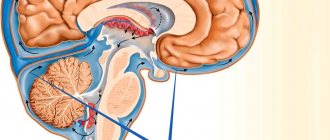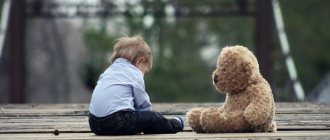Classification of fears in children
As children, most of us experienced fears. Moreover, they were often associated not with real danger, but with our fantasies. Psychologists have identified three main types of fears in preschoolers:
- Fears that arise after experiencing stressful situations (for example, after going to the doctor, being stung by a bee, etc.).
- Fears arising from fantasy. The imagination of preschoolers is so well developed that they involuntarily transfer the events of fairy tales and cartoons into real life, while adding new details.
- Fears arising from suggestion. Sometimes, in an effort to quickly achieve the desired behavior from a child, we intimidate him: “Go to sleep quickly, otherwise a little gray wolf will come and bite you on the side,” “Don’t run far, otherwise someone else’s uncle will take you,” “If you want, stay here, but I'm leaving". Of course, having heard such a warning, the child will most likely comply with your request. However, if we constantly remind a child of the possible danger lurking around every corner, he may develop increased anxiety.
Each age is characterized by certain fears. Babies are afraid of separation from their mother and loud noises. After 7 months, children usually develop a fear of strangers and new surroundings. After 2 years, children may be afraid of doctors, monsters, and loneliness. In preschool age, fears of the dark, punishment, and death may arise. Fears are part of normal child development. There is no need to be afraid or ashamed of this. Our task is to help the child overcome his fear.
Causes of children's fears
- Congenital characteristics, temperament, personality traits (increased emotionality, sensitivity, anxiety).
- Stress. For example, illness, parental divorce, death of a loved one, injury.
- Unfavorable family environment. Parents' scandals, drinking family members, and insufficient attention to the child may be the causes of his anxiety.
- Overprotection. Total control over the child and excessive care can lead to the fact that the child begins to be afraid of everything.
- Mental disorder. If the child's fears are too strong or do not correspond to his age, the help of a specialist is needed.
Children's multidisciplinary medical center for children from 0 to 18 years old
07/24/2017 The age of fear in children is usually 3-7 years. At this time, almost everyone is afraid of something. Usually children are afraid of the dark, big dogs, being alone, etc., and this is a normal developmental process that you just need to go through, just like you went through the teething period or any other stage in life.
The nature of childhood anxiety also depends on the psychological constitution. Just like adults, children are more impressionable. Some people dream of heroic deeds and rush into any fight, while others just want to sit with a toy in the corner. It is obvious that if a child initially has a subtle mental organization, he will be more susceptible to fears than someone else.
As a rule, any fear begins with a specific situation. For example, a child began to be afraid of doctors after he experienced pain during treatment.
It happens that children subconsciously perceive fears or anxiety, tension in their parents’ relationships and demonstrate their own fears to adults, but in their own childish way.
The nature of the parent-child relationship is also of great importance. If they are too detached or, on the contrary, tend to be overprotective, or unpredictable, this can also lead to an increase in anxiety and the appearance of fears.
What will help your child cope with fears:
1. Fairytale therapy. Choose a fairy tale or cartoon with a plot similar to your child’s problem and discuss it with your child.
Come up with your own fairy tale where the main character overcomes his fear and becomes a winner. It is important, through a fairy tale, to show the child other ways of behavior and solutions to troubling issues that will help him get out of the “victim” position.
2. To work through the topic of fear, it is also good to use art therapy methods. Let's say a child is afraid of doctors, then you can play with toys in a doll hospital, where the child will play the role of a doctor, and another time in the role of a patient. During the game, show the desired behavior and state through the characters, explain how he can do this himself. Be sure to provide your child with emotional support: hug, praise him.
3. You can offer to draw what he is afraid of. “When you're afraid, what does it look like? Draw!
Then try to “sound”: “And if your fear could speak, what would it say? What do you want to tell him? What do you want to do with him?
For example, make it small or turn it into something good, or simply tear a leaf and thereby destroy the fear.
Be sure to ask your child what he wants to be? Do you want to be brave? What will help him with this? For example, a magic sword or a magic dress. Ask your child to draw a picture of himself being brave and possessing this magical item in a situation where it is needed.
4. It is very useful to regularly discuss with your child what worries him, explain why certain events happen, draw them or sculpt them, and in the end always say that he will cope with everything, everything will be fine, that you love him and will always help.
5. It is also important to help the baby create a new positive image of himself, “I am brave.” Regularly pay attention to manifestations of courage in the child’s behavior, and reinforce them with appropriate words, tell others about them (so that the child can hear), etc. Thus, you consciously create resource states in the child, which he can turn to in difficult moments of his life.
6. In addition, it is useful to carefully plan events where the baby may be scared, for example, a visit to the dentist. Before starting treatment, introduce the child to the doctor, be sure to mention the doctor’s name, warn him about the child’s fears, and ask him to spend time with the child before starting treatment, tell him in detail what will happen and how. During the procedures, be nearby, support the child emotionally, and maintain physical contact if possible. It is important that YOU yourself demonstrate inner calm and confidence, because children are very sensitive to the emotional state of adults and easily “read” them. After the event, plan pleasant events, prepare an inspiring gift, create a support group.
Thus, your help to the child consists of two parts
1. You help him figure out what scares or worries him, give him a clear explanation and tell him what will happen next. You play out the solution options through a fairy tale, drawing, modeling or theatrical performance, in which the child finds a new way of behavior and emerges as a winner.
2. Create an emotionally positive foundation and a new image of “I am brave” through the use of appropriate behavioral models.
And most importantly, you yourself must be calm and positive, only under this condition will your child also be calm, cheerful and successful.
Useful books on the topic:
- B. Doris “Once upon a time there was a girl like you...”
- E. V. Zinkevich-Evstigneeva “Workshop on fairy tale therapy”
- V. Oaklander “Windows into the world of a child”
- S. Prokofiev “Fairy Tale Machines”
- J. Donaldson and Axel Scheffler "The Gruffalo" and "The Gruffalo's Daughter"
And cartoons:
- "Tari Bird"
- “Not at all scary” and “Ahi-fears”
- "Be Brave"
- "Little Raccoon and the One Who Sits in the Pond"
The article was written using materials from the work of Anna Bravoslavskaya.
How to help your child overcome fear
As we have already said, fears in childhood are normal. But while they may seem funny and stupid to us, for a child this is a real problem. Let your child feel that you can be trusted, do not laugh at his fears. If you want to help your child overcome fear, do not ignore it, listen to your baby, let him know that he is safe.
Next, we will take a closer look at the most common fears in preschool children and ways to overcome them.
How to recognize childhood fear?
In babies, fear is expressed in freezing or, conversely, in increased motor restlessness; they cry, hide behind their mother, or run away. The source of fear in this case is not difficult to identify.
Preschoolers and schoolchildren cannot always talk about what scares them. Parents should be wary of the child's constant tension, motor agitation, increased fatigue, restless sleep, frequent headaches, moodiness and tearfulness. All this suggests that the child is in a state of chronic restlessness and anxiety, and he will need the help of a psychologist.
The main methods for diagnosing fears in children over 3 years of age are based on drawings (“Drawing of a family”, “Draw what you are afraid of”). Methods such as “Fears in the Houses” and “Finish the Fairy Tale” are also used. With their help, you can find out what worries and worries the child, what fears predominate in him.
In high school and adolescence, psychologists use questionnaires that allow them to assess the degree of psycho-emotional stress of the child, the level of anxiety and predisposition to neurosis.
Carefully find out what is really going on with your child and help him cope with his fears. Install the “Where are my kids” parental control app to know where he is, what he is doing and who he is spending time with.
Fear of the dark
Most of us are afraid of the dark. In the dark, children feel defenseless and fear of the unknown appears. To reduce your child's anxiety before bed, leave the hallway door open or turn on a night light. Let your child control the lighting in his room. To make your child friends with the dark, go for walks in the dark, discuss what interesting things can be seen in the dark (stars, fireflies, etc.).
Clinical manifestations of adolescent phobias
At a certain age and in certain situations, anxiety and fear are a normal reaction of the body to what is happening around. For example, anxiety before an upcoming test, exam, performance at school/university, or a first date is quite understandable. In this situation, anxiety, on the contrary, helps to mobilize all the body’s resources before an important event and act more effectively.
Important!
Unlike physiologically and psychologically normal anxiety, phobias are irrational. They are not associated with a real threat, fear is accompanied by a feeling of one’s own helplessness, completely takes over the consciousness, and negatively affects the way of life, because the teenager strives with all his might to avoid the circumstances that provoke such a feeling.
Constant worry and anxiety bring discord to almost any activity. Academic performance declines and hostility may appear. Low self-esteem, a feeling of self-doubt, dependence on the opinions of others, and lack of initiative are typical.
Classification
Depending on the content of fears, there are several forms of teenage phobias:
- Social phobia: an intense fear of being the center of attention, or of saying or doing something that will cause ridicule or disapproval from others. With agoraphobia, people are afraid of public speaking, avoid eating in cafes, parties, clubs and discos; sometimes the patient, despite physiological needs, cannot overcome himself and visit a public toilet.
- Agoraphobia ; fear of being in a crowd, public place, or transport. This form of phobic disorder is characterized by attacks of panic attacks, which are accompanied by increased heart rate, shortness of breath, tachycardia, and possible disturbances of consciousness and disorientation.
- Specific (isolated) teenage phobias. They are distinguished by the appearance of uncontrollable fear in a strictly defined situation or in front of any objects. This could be a fear of heights, darkness, animals, insects. Sometimes this is ignored for a long time, as the teenager (and his parents) adapt to it, avoiding situations that provoke anxiety.
A separate group includes school phobia, which manifests itself as a fear of assessing knowledge, not meeting the requirements of teachers, moving to the next grade, another school, etc. In such cases, frequent absenteeism and avoidance of attending classes under any pretext are typical.
Fear of monsters
To make it clear to a child that monsters do not exist, you should not try to explain it logically. For a child, his fantasies seem much more real than your arguments. Before going to bed, look with your child under the bed and in all other places where, in your child’s opinion, a monster might be hiding. A fun ritual that drives away monsters can help a child get rid of fear. You can also try to describe the monster so that it seems funny and absurd to the child. Funny can't be scary.
How to fight?
- Conversation about fear.
The simplest thing that can help in the fight against fear is conversation. During the dialogue, be calm and speak slowly. The more a child talks about his fear, the faster he can get rid of it. - A story or tale about fear
. Together with your child, compose a fairy tale on the theme of his fear. It is important that at the end of the fairy tale there is a hero who conquers fear. - Drawing of fear.
Art therapy methods are very effective in combating fear. After the child draws, you can burn or tear up and throw away the drawing of fear. Praise the child, drawing his attention to how well done he is for overcoming fear. - Identify the source of fear.
Some sources of fear can be easily eliminated. For example, if a child is afraid of the dark, then at night you can light a small night light for him. - Talisman for fighting fear.
Create or have your child choose an object that will support him when he is afraid. - Praise and support.
Increasing a child's self-esteem helps eliminate many fears. - Tell your child about your fears
and how you overcame them. - Create a protective ritual.
For example, a “protector from fears”: a teddy bear or some magic words.
Important!
- Do not act with force, this will worsen the child’s fear.
- Don't shame your child for showing fear.
- Eliminate external frustrating factors.
Nightmares
Children often don't want to go to bed because they're afraid they'll have a nightmare. Psychologists believe that dreams are in many ways a reflection of our lives. The cause of nightmares may be the child’s negative emotional state. Try to protect your child from an overabundance of information and impressions, from swearing and scandals, praise the child more. To make your baby fall asleep easier, spend more time outdoors. Stay next to him until he falls asleep, put his favorite toy next to him. If your child has nightmares too often, you should seek help from a specialist. To deal with this problem, you can attend individual sessions with a psychologist in children's. Sand therapy will also help relieve anxiety and overcome a child’s fears.
According to research, the most common characters in nightmares among preschool children are the Wolf and Baba Yaga. These characters are the personification of evil, strict, irritable adults whom the child is afraid of in real life.
What to do if your child is afraid of everything
Each child's age has its own special “horror stories”. They all have a specific function and help the baby adapt to changing living conditions as he grows up.
From 6 months to 2 years
The first fears appear already in infancy. At about 6 months, a child may cry when he sees a stranger in front of him. This fear is associated with the distinction between friends and strangers, which causes a sharp reaction in the baby.
At the age of 7-9 months, the child begins to move, crawl and, as he learns, faces various dangers: inedible objects, animals and insects, and becomes familiar with the categories of hot/cold. This is how fear of frightening situations, loud sounds, and unfamiliar objects appears.
At 2-3 years
During this period, objective fears are formed. They are caused by the instinct of self-preservation: such emotional reactions help to avoid something potentially harmful. For example, loud sudden sounds, loneliness (mom left or left alone in the room), injections and pain from medical procedures invariably frighten the baby. Psychologists observe a relationship between the level of intellectual development of a child and the number of subject-related fears during this period. The smarter the baby, the more frightening situations he is aware of.
It is at this age that fear of the dark and nightmares appear, as a consequence of the fear of losing mom. This is a particular manifestation of the fear of loneliness, associated with the need for security and care.
Fear of fire, fire, natural disasters (hurricane, thunder, earthquake), and animals may also appear. These fears are believed to be necessary for the child's survival.
Such stories can become the basis for a child’s scary dreams. If you are faced with the problem of nightmares in children, read more about it in the article “Does your child have terrible dreams? Don't panic!
At 4-7 years old
Fears of this age can be divided into 2 main categories: imaginary and inspired. Both of them are not associated with real dangers, but are manifestations of the child’s wild imagination. So the baby can begin to be afraid of literally everything: the dark, natural elements, fairy-tale characters, animals, bandits and wars.
If the fear is imaginary, then its source is the child himself. This is an inevitable stage in the development of abstract thinking and the ability to fantasize in preschool age.
If the fear is instilled, then the reason for its appearance was the stories of peers, relatives, books and fairy tales. Children of this age love to tell each other “horror stories”, while experiencing mixed feelings of anxiety and pleasure from the effect produced. And older relatives, especially grandparents, like to intimidate the child with the consequences of certain actions: “don’t come near - you’ll fall”, “don’t stroke - he’ll bite”, “the grandma will take you away”, “the top will carry you away”.
For impressionable children, it is better to limit scary content. You should not discuss fires, murders, accidents in front of him - all these stories will instantly be reflected in the child’s fantasies.
A separate category is the so-called existential fear - the deep fear of death - one’s own and that of one’s parents. The kid slowly realizes that life is finite, and this discovery scares him. Some children are afraid to go to sleep because they might die in their sleep. These fantasies are reinforced by the stories of relatives who are unable to explain the phenomenon of death: “grandmother fell asleep and will not wake up again.”
What makes children's fears worse?
Parents should understand that many factors influence the appearance of fear of a particular subject. This is an environmental influence such as:
- conflict family situation, quarrels, disputes;
- death or illness of a relative;
- tense situation in the child’s team (resentment from peers, blackmail, conflicts);
- high anxiety of parents themselves;
- too authoritarian, harsh type of education;
- overprotection from parents;
- isolation of the child from communication with peers;
And the mental characteristics of the child himself.
Children with impressionable characters suffer the most from fears. They are more sensitive by nature and tolerate situations of uncertainty less well. I wrote more about such babies in the article “The child is afraid to be left without his mother.”
Impressionable children are more easily susceptible to instilled fears. They are more prone to anxiety: any push from the outside, especially the words of an authoritative adult, can become a “trigger” for the appearance of obsessive thoughts and images that frighten the baby.
What do children's fears lead to?
Is it really that dangerous? Maybe you should just let your child “outgrow” this period or wait until he learns to cope with difficulties himself?
Unfortunately, the abundance of fears and anxieties in a child’s life greatly reduces its quality. Against their background, the following may appear:
- low self-esteem, lack of self-confidence;
- lack of will, a feeling of doom, because the child does not know how to cope with the “monsters” that are pursuing him;
- outbursts of unmotivated anger (due to an exhausted nervous system and suppressed aggression);
- disruption of relationships in the team, social isolation (the child withdraws into his experiences and fears, devotes less and less time to communication);
To prevent these unpleasant consequences from occurring, let's learn to help the child work on fear.
Fear of separation from a significant adult
Parents (or people replacing them) are the closest and dearest people to a child. When a parent leaves somewhere, the baby fears that mom or dad may not return to him. This situation often arises when a child just starts going to kindergarten and goes through a period of adaptation. To help your child cope with separation anxiety, when you go somewhere, be sure to say goodbye to him, explain where you are going and when you will return, otherwise the baby may think that he was abandoned. If you keep your promises and come on time, the child will understand that his loved one always returns to him, and will no longer be afraid of your leaving.
Fear of loneliness
Some babies get used to being inseparable from their mother and are afraid to be left alone even for a short time. To help your child overcome fear, start teaching him to be alone (in the good sense of the word). When your child learns to play alone, gradually move away from him. First it may be the other end of the room, then the next room. Leave for a short time so that the baby does not have time to get scared. Over time, your child will get used to your temporary absence.
You can help your child get rid of fears only if you understand how serious this problem is for the child. Remember that your baby expects acceptance and support from you.
Fear of animals
Children, like adults, can be afraid of animals. This fear is completely justified, because we don’t know what to expect from other people’s pets. You should not ignore such fears and laugh at your child if he is afraid of any animal. Try to support him. Show your child an example of interacting with animals. But don't expect quick results. The child will get rid of fear if for some time he sees you calmly petting your neighbor’s dog. Tell us what you can and cannot treat our little brothers.
Fear of death
Preschool age is the time when a child begins to become aware of things related to death. Children may spot a dead animal on the street, accidentally hear about someone's death in an adult conversation, or experience the death of a loved one. Realizing that all living things eventually die, a child can experience extreme stress. If the child himself talks about the fact that he is upset by someone’s death, you have a great chance to help the child deal with his fear. Don’t hide from the answer, explain to your child that death is something that happens to everyone and there is no need to be afraid of it. If a stressful event related to death has occurred in a child’s life, but the child does not talk about his experiences, encourage him to express his feelings through creativity (art therapy, sand therapy, skozkotherapy) and play. The fear of death in a preschool child may not appear immediately after a traumatic event. Be attentive to your child, show delicacy.
Children's fears: causes and ways to overcome them
Is your five-year-old afraid of the dark and asks to stay in his room until he falls asleep? This is fine! Our new blogger, psychologist Anita Vayakanti, tells us what childhood fears arise in children of different ages, what they are associated with and how to help your child cope with them.
Useful Mela newsletter twice a week: Tuesday and Friday
SUBSCRIBE
One of the most common requests from parents in my consultations is children's fears. Parents want to help their child overcome them and, of course, find out the reason for their appearance. Childhood fear is a feeling of anxiety or restlessness in a child under 16 years of age.
I think it is very important to pay attention to children's fear and help the child overcome it. When a little person overcomes his fears with the support of his parents or a specialist, he learns what protection, support and inner strength (of himself) are to the fullest. This knowledge and experience helps him in developing such qualities as courage, confidence and initiative.
Why is it so important to overcome fears, I said, now let's discuss the possible reasons for the appearance of children's fears. Probably my most popular answer to this question is that there are so-called age-related fears. That is, at a certain age, children develop certain fears, which are determined by the formation of the psyche, brain and, of course, their experience.
Age periods and fears that appear in them:
From 0–1 year
: fear of separation from mother; strangers; doctors; injections; noise (sharp and unexpected sounds); fear of depth (when swimming).
At 1 year
: in children in the second year of their life, fear of loneliness and unfamiliar adults may prevail.
At 2–3 years
: fear of punishment; animals; fear of pain; heights and moving traffic.
At 4–5 years old
: fear of fairy tale characters or any fictional heroes; darkness; loneliness; fear when falling asleep.
At 6–7 years old
: fear of death (your own or loved ones); animals; fairy-tale characters; scary dreams; fear of fire; darkness; ghosts.
At 8–10 years old
: school fears predominate (being late for school; fear of answering at the blackboard; fear of a test; fear of teachers; reprimand). Fear of the other world, trouble. Boys may also have a pronounced fear of death.
At 11–16 years old
: fear of death, war, elements, attack; fear of getting sick with something serious; fear of expressing oneself; fear of change (this is due to physiological changes in the body of adolescents).
Now we know what fears prevail in children’s minds at what age, it’s time to understand their causes.
Causes of strong childhood fears:
1. Negative childhood experiences
- this is any traumatic situation, that is, something that greatly frightened the child: a dog, a train, a loud scream, and so on.
2. Mistakes in education
- disturbed attachment, lack of harmonious relationships between mother and child can serve as a catalyst for children's fears.
3. Anxious parents
- emotional anxiety, tension in adults, an attitude of failure and the presence of one’s own unresolved fears (especially in the mother) are transmitted to the child. Attitudes such as “You will fall”, “You will hit yourself”, “You may be hit by a car” and so on form a feeling of anxiety in the child, which then transforms into fear.
4. Conflicts and aggression in the family.
Conflicts between parents greatly affect children. Children often feel guilty for their parents' quarrels and are afraid of being the cause of them. Aggressive behavior towards any person has never been recognized as positive. When parents dominate, punish and dominate, the child loses basic trust in the world and a sense of security. As a result, such children are in constant anticipation of trouble, which creates the manifestation of fears.
5. Films, computer games, videos.
Children who had seen enough scary videos on YouTube were often brought to me for consultations. It is not for nothing that films have age restrictions, because children cannot critically look at what is happening in the plot (be it a film or a game) and begin to fear the repetition of such situations in their lives.
6. Mental disorders.
Fear can be a sign of neurosis, neuropathy. In order to determine this, you need diagnostics from several specialists.
What can help a child cope with fear?
1. Communication.
Talk to your child, ask him what he is afraid of and why. Talk about your fears and what helped you overcome them. If the child does not want to answer, then ask what his toy is afraid of (in a playful way). Verbalizing fear dulls its power and it decreases.
2. Drawing and sculpting.
You can draw fear and throw it away, you can fill it with water, or you can draw yourself next to it—“not afraid.” You can mold and change something in it, make it funny.
3. Fairy tale.
You can write a fairy tale together. Ask your child to compose a story in which he is the main character and faces something scary (it is important to carefully lead up to this), let the child give free rein to his imagination, but at the end, be sure to ask him to complete the fairy tale so that he emerges victorious. Read fairy tales where the main character conquers his fears. Discuss them.
conclusions
So, we have listed for you the fears that are most often found in preschool children. Some of them may seem insignificant and even funny. But believe me, this is a serious experience for a child. In a calm environment, talk to your baby about what is bothering him. Try to make him feel safe. Playing out stressful situations, drawing your fears, fairytale therapy and sand therapy will help you get rid of your fears.
Fears are the leading manifestation of anxiety disorders in children. Various anxiety disorders occur in 15-20% of children and adolescents [1]. According to S. Essau and J. Gabbidon [2], at various periods in childhood and adolescence, the frequency of anxiety disorders reaches 9-32%. According to A.G. Golovina [3], the prevalence of this pathology is much higher, but only a small proportion of children with psychopathological symptoms reaching a clinical level receive medical care.
The medieval physician Ibn Sina (Avicenna) wrote that in humans, unlike animals, fear is associated not only with the immediate perception of a threat, but also with the premonition that something will happen that will harm him. According to K. Izard [4], anxiety consists of many emotions, one of the components of which is fear. Unlike fear, anxiety is usually pointless, irrational and has no specific stimulus. The distinction between anxiety and fear is usually based on the criterion introduced into psychiatry by K. Jaspers, according to which anxiety is felt without connection with any stimulus (“free-floating anxiety”), while fear is correlated with a specific stimulus and object. The famous child psychiatrist H. Remschmidt [5] believes that fears cause changes on three levels: at the level of experiences of fear, damage, etc.; at the level of behavior: avoidance strategy (escape, evasion); at the physiological level: increased heart rate and breathing, sweating.
At the same time, it must be remembered that a child’s fears can also be a “normal” manifestation of adaptation. If the fear has little impact on the child's daily life or lasts only a few weeks, then it is most likely part of normal development. But since children and their environment are constantly changing, fears that are normal at one age can become an obstacle to the development of social interaction skills at another [6]. Anxiety, which arises as a response to an uncertain or threatening situation, as well as to a lack of information, is a normal adaptive reaction that mobilizes the body in the event of a real threat or difficult situation. Charles Darwin wrote that the ability to experience fear, being an innate feature of humans and animals, plays a significant role in the process of natural selection. In his opinion, over the course of many generations, this adaptive mechanism was improved, since the one who was most skillful in avoiding and overcoming danger won and survived.
The development of anxiety disorders in children occurs through the interaction of biological, psychological and environmental factors. Risk factors include parental anxiety, the child's personality traits with a tendency to withdraw, traumatic (negative) stressful events in the child's life, and parenting style.
The role of hereditary burden of anxiety disorders should also be noted. A study by C. Last et al. [7], showed that anxious children are more often raised by anxious parents than their non-anxious peers. Hereditary burden of anxiety disorders is observed in 40-50% of children [8]. A. Caspi et al. [9] suggest that reduced resistance to stress is inherited. According to E.L. Kazantseva [10], phobic disorders in children and adolescents predominantly develop on an altered biological and/or socio-psychological “soil”, immediately after additional acute situational or somatic harm.
T. O'Connor et al. [11] and K. Bergman et al. [12] studied the impact of antenatal maternal anxiety on child development. It was found that a high level of anxiety at 32 weeks of pregnancy doubles the risk of emotional disturbances and hyperactivity and attention disorders in the child at the ages of 47 and 81 months in boys and girls. Anxiety at 18 weeks also contributed to the development of behavioral and emotional problems, but only in girls. Particular attention is paid to the role of stress in the perinatal period in the occurrence of anxiety disorders in children in the works of K. Beesdo et al. [1] and R. Fine et al. [13].
B. Van der Bergh and A. Marcoen [14] suggested that in children of anxious mothers, the monoaminergic systems of the brain (including the hypothalamic-pituitary and limbic) can be prenatally programmed by the damaging effects of hormones that mediate anxiety at 12-22 weeks gestation.
A child's innate temperament and parenting style are also mechanisms that influence the relationship between parental and child anxiety [15]. Particular attention is paid to behavioral inhibition.
[16]. Such children are characterized by pronounced uncertainty when entering unfamiliar social situations. Approximately 15–20% of children in the population are characterized by a similar temperament [17].
According to W. Jacobs and L. Nadel [18], the emergence of phobias is based on a combination of immaturity of the nervous system (especially hippocampal structures) and the experience of fear. The fear reaction that occurs when danger appears is developing, but the person still does not know how to correctly differentiate between dangerous and safe situations.
A. Etkin and T. Wager [19] noted that patients with anxiety disorders have pathological overexcitation in the amygdala and insula. Anxiety activates the fear circuit, which includes the amygdala, ventral prefrontal cortex, and anterior singulate.
cortex [20]. Deficits in emotional regulation make it difficult to overcome “normal” fears or get used to them. Dishabituation (lack of habituation) of fears causes the return of the overcome fear.
When talking about the causes of the development of anxiety disorders in children, it is necessary to put the role of psychotraumatic factors in the first place. V.V. Kovalev [21] identified the following types of psychotraumatic situations in childhood: shock, short-term situational, chronic psychotrauma and emotional deprivation.
According to the theory of J. Bowlby [22], child-maternal attachment is characterized by the presence of reliable and stable relationships between the child and the adults caring for him. According to the author, attachment is a behavioral system that is determined by the closeness of the mother and her care for the child. The main factor preventing the occurrence of anxiety and fear is the emerging expectation that in dangerous situations the object of attachment (most often the mother) will always be nearby. If a child has acquired this foundation of security, then he dares to explore the world around him in the presence of his attachment figure. Belief or disbelief in the object of attachment is formed depending on real experience, from early childhood to adolescence and, according to J. Bowlby, remains in its originality throughout life. The most important phase is the period from the 6th month to the 5th year of life. At this age, the author believes, the most important task of child development is the formation of attachment. Frequent manifestations of attachment behavior towards parents clearly weaken only with the onset of adolescence. If the child is not allowed to experience warmth, closeness and an ongoing relationship with the mother or some other attachment figure, then homeostasis is disrupted. J. Bowlby calls this condition deprivation
. If in early childhood a child experiences uncertainty that the object of attachment is at his disposal, then, according to J. Bowlby, anxious and insecure attachment behavior is formed. Children who perceive the world around them as unreliable, inaccessible, hostile or threatening may subsequently develop severe anxiety and avoidant behavior patterns. Signs of a secure attachment are the following: 1) the attachment figure can calm the child better than others; 2) the child turns to the attachment figure for comfort more often than to other adults; 3) in the presence of an attachment figure, the child experiences fear less often [23].
According to H. Sullivan [24], if a child has a sense of interpersonal reliability from the very beginning, it will prevent the development of anxiety. The main source of anxiety for a child is disapproval from significant people. At the same time, personality is an adaptive formation, which is largely based on the experience of anxiety.
When describing the manifestations of fears, it is necessary to touch upon such a concept as a phobia - an obsessive experience of fear with a clear plot in the presence of sufficient criticism. Such fears become aggravated in certain situations and are vivid, figurative, and sensual in nature. They are usually extremely painful due to an ambivalent attitude towards them - the ongoing experience of fear against the backdrop of an understanding of its groundlessness. Patients view their experiences as painful weakness, lack of will, and strangeness. An essential feature of phobias is a pronounced struggle with them [25]. S.N. Davidenkov [26] argued that complete preservation of criticism is characteristic only outside of attacks. It should be noted that children, unlike adults, are not always critical of the content of phobias. They are often convinced that a frightening stimulus poses a serious threat. Unlike most adults who suffer from specific phobias, children often do not understand that their fears are excessive and unreasonable.
About 2–4% of children experience specific phobias at some point in their lives [27]. Children with specific phobias have an excessive, pathological fear of something that poses little or no threat or danger.
Anxious children are hypersensitive to threatening events and tend to interpret ambiguous situations as threatening.
Most childhood phobias are associated with natural dangers and frightening stimuli that have haunted humanity throughout its development. These include: snakes, darkness, predators, heights, blood, loud noises and unfamiliar places. Phobias related to animals, the dark, insects, blood, and injury typically begin between ages 7 and 9, making them similar to fears that characterize normal development. However, clinical phobias tend to persist for a much longer time than normal fears, although both diminish over time. The most common fears in infants, children and adolescents according to E. Mash and D. Wolf [6] are listed in the table.
Fears that arise in infancy, childhood and adolescence [6]
The fears of preschool children are characterized by simple, concrete content and a combination with bright, visual, frightening images. The most common fear is fear of the dark (nyctophobia). Children who are afraid of the dark are afraid to sleep in a dark room and tend to stay in their parents' bed.
At primary school age, fear of loneliness (isolophobia) is often noted. This fear can be classified as a manifestation of agoraphobia. The term agoraphobia is used here in a broader sense than when it was originally introduced, or as it is still used in some countries. It now includes fears not only of open spaces, but also of situations close to them, such as the presence of crowds and the inability to immediately return to a safe place (usually home).
As a child grows up, concerns about health and death arise [28]. X. Remschmidt [5] notes that by the age of completion of puberty, fears associated with society begin to occupy a leading position among fears.
A.G. Golovina [3] writes that if in the 60-70s researchers recorded a high frequency of such phenomena as fear of outer space and alien invasion, then by the end of the twentieth century they are observed less and less often and in recent years have practically not been mentioned and, vice versa , mystical fears appeared, generated by the flow of information, cultivating prejudices and superstitions, supporting a tendency towards “magical thinking” (fear of brownies, spirits, ghosts, werewolves, vampires).
Our previous study [29] showed that the mental state of children with anxiety-phobic disorders is characterized by comorbid attention and memory disorders. A psychophysiological study using the continuous activity test TOVA (the Test of Variables of Attention) revealed a significant increase in inattention and, especially, impulsivity in children with phobias compared to children from the control group. In addition, psychological studies have shown that children with this pathology have indicators of short-term auditory-verbal and visual memory that are significantly lower than the corresponding indicators observed in their healthy peers. The connection between mnestic and anxiety disorders in children was also pointed out by R. Vasa et al. [thirty]. It can be assumed that the comorbidity of phobic disorders and cognitive impairment is based on changes in the plasticity of the nervous system.
Tranquilizers (anxiolytics) play a leading role in the treatment of neurotic fears. This group includes psychopharmacological agents that reduce the manifestations of anxiety, emotional tension, and fears. Given the side effects of drugs from the benzodiazepine group, non-benzodiazepine tranquilizers have recently been more actively used for the treatment of anxiety disorders.
Along with them, the so-called tranquilonootropes are widely used in the treatment of this pathology, a prominent representative of which is noofen (aminophenylbutyric acid). A distinctive feature of the drug Noofen is that it has the properties of both a tranquilizing and nootropic drug. The nootropic property is based on antihypoxic action, improvement of GABAergic neurotransmitter transmission, increase in energy resources, activation of metabolic processes, improvement of the functional characteristics of neurons. It must be taken into account that noofen (as a phenylethylamine derivative) has dopamine-mimetic properties, which enhance its antiasthenic effect. In addition to the nootropic, noofen also has a moderate tranquilizing (anxiolytic) effect, reducing tension, anxiety, fear, emotional lability, tearfulness, irritability, and normalizes sleep [34, 35].
The tranquilizing effect of noofen is associated with its ability to enhance the controlling function of cortical structures over subcortical ones, including limbic ones, due to the pathogenetic effect: improving GABAergic neurotransmitter transmission [35]. The anxiolytic effect of the drug manifests itself both in reducing anxiety and in reducing fear of speech, which is very important in the treatment of stuttering. According to O.S. Chaban and E.A. Khaustova (2009), the pharmacological effect of noofen is dose-dependent: with increasing dose of the drug, its tranquilizing activity increases [36].
The combination of these effects is a great advantage of Noofen, since it allows you to take only one drug instead of two with an isolated effect. This is especially important when using medications in children.
Noofen is available in 250 mg capsules. The use of a dosage form in the form of capsules allows you to increase the absorption of the drug and protect the gastric mucosa. Noofen is prescribed to children from 8 to 14 years old - 250 mg 2-3 times a day, over 14 years old - 250-500 mg 3 times a day for 4-6 weeks.
Taking into account the fact that tics and stuttering are common accompaniments of anxiety disorders in children, the results of our studies are very important, indicating the high clinical effectiveness of Noofen in the treatment of tics, both transient and chronic [37]. In addition, the use of Noofen made it possible to reduce stuttering. Improvement was obtained in the majority of patients with both neurotic and neurosis-like variants of this disorder. Repeated psychological studies after completion of treatment revealed a decrease in anxiety levels in 83% of children with stuttering. It should be noted that patients with neurotic stuttering showed a decrease in logophobia (fear of speech).
A comparative analysis of the results of an electroencephalographic study showed that after completing a course of Noofen, positive dynamics were noted in the form of an increase in the representation of alpha activity in the occipital regions, which indicates an improvement in the functional state of the brain [37].
In addition, we have shown that the use of Noofen can significantly reduce the manifestations of protracted anxiety-phobic disorders. Of particular note is the pronounced decrease in the manifestations of autonomic dysfunction after treatment. The results of psychophysiological studies confirmed the clinical data and indicated a decrease in neurocognitive deficits after a course of Noofen [38].
An important feature of the drug is the low incidence of side effects. In rare cases, while taking Noofen, transient daytime drowsiness was noted or, conversely, an increase in motor activity and difficulties in falling asleep were recorded. These undesirable symptoms may appear at the beginning of the course and disappear after 2 weeks during treatment. It should be noted that these manifestations do not lead to interruption of therapy. No other side effects were identified.
Thus, Noofen is a highly effective and safe treatment for anxiety disorders in children and adolescents.











